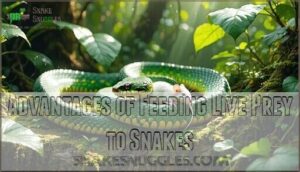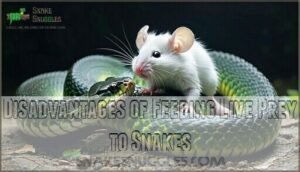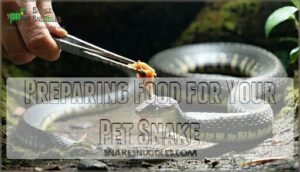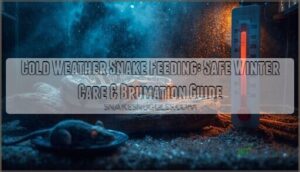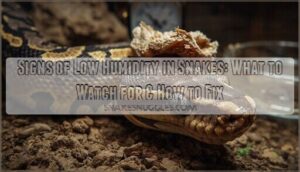This site is supported by our readers. We may earn a commission, at no cost to you, if you purchase through links.

Your snake doesn’t need the stress of a wrestling match either. Pre-killed frozen prey is safer, cheaper, and just as nutritious.
If you must use live prey, choose healthy specimens from reputable suppliers and supervise closely. Never leave prey unattended with your snake.
Size matters too – pick prey that’s roughly the same width as your snake’s thickest part. There’s more to master here, including ensuring the prey is the right size for your snake’s needs.
Table Of Contents
- Key Takeaways
- Live Prey Vs. Frozen Prey
- Advantages of Feeding Live Prey to Snakes
- Disadvantages of Feeding Live Prey to Snakes
- Choosing Appropriate Food
- Frequency of Feeding
- Understanding Your Snake’s Feeding Habits
- Preparing Food for Your Pet Snake
- The Dangers of Overfeeding
- Feeding Techniques
- Encouraging Stubborn Snakes to Eat
- Frequently Asked Questions (FAQs)
- How to get a snake to eat live food?
- How do snakes eat prey alive?
- Do snakes need to be live feed?
- How do you feed a snake?
- What do snakes eat?
- Should pet snakes eat live or frozen prey?
- Can a snake eat live prey?
- Is it better to feed snakes live or frozen?
- Do some snakes eat their prey alive?
- Can I feed my ball python live?
- Conclusion
Key Takeaways
- You’ll face serious risks when feeding live prey, including injuries from defensive bites, disease transmission, and parasite infections that can cost you expensive vet bills and harm your snake’s health.
- You must choose prey that’s 10-15% of your snake’s body weight and no wider than your snake’s thickest part, while supervising feeding sessions constantly and removing uneaten prey immediately to prevent overnight attacks.
- You’ll find frozen-thawed prey safer, cheaper, and more convenient than live options, eliminating injury risks while maintaining nutritional value and reducing storage hassles and ethical concerns.
- You can encourage reluctant feeders by using feeding tongs to create realistic movement, trying scent tricks like braining prey, offering food during low-light conditions, and being patient as some snakes need weeks to adjust to new feeding routines.
Live Prey Vs. Frozen Prey
The choice between live prey and frozen-thawed prey isn’t just about convenience—it’s about weighing safety differences, ethical concerns, and your snake’s preferences.
Live prey offers superior nutrient comparison with enhanced vitamins and minerals, plus natural movement that stimulates hunting instincts.
However, it carries significant risks including injuries from defensive bites and higher parasite loads.
Frozen-thawed prey eliminates these dangers while remaining nutritionally adequate for most species.
Cost analysis reveals live prey expenses add up quickly, while ethical implications around animal welfare make many keepers uncomfortable, considering the animal welfare.
Your snake’s individual preferences and your comfort level ultimately guide this decision.
Advantages of Feeding Live Prey to Snakes
While live prey feeding carries risks, it offers several distinct benefits that you’ll want to take into account for your snake’s health and behavior.
Live prey provides superior nutrition, stimulates natural hunting instincts, and can encourage feeding in snakes that refuse frozen alternatives.
More Nutrients
Now that you understand the basic differences between live and frozen prey, let’s explore why live prey feeding offers superior nutrition for your snake.
Live prey delivers unmatched nutritional benefits that can substantially impact your snake’s health and vitality.
Live prey provides your snake with peak nutrition that frozen alternatives simply can’t match for optimal health.
When you choose live prey feeding, you’re providing your snake with prime nutrient density.
Fresh prey maintains higher levels of essential vitamins and minerals compared to frozen alternatives.
The natural cellular structure remains intact, promoting better vitamin retention and enhanced mineral density throughout the feeding process.
Live prey feeding supports superior nutrition through active enzymatic processes that frozen prey simply can’t match.
Your snake benefits from improved nutrient absorption, as the prey’s natural body temperature and fresh tissue structure optimize digestion.
This dietary balance closely mimics what snakes experience in their natural habitat.
However, it’s important to acknowledge that live prey poses risks that must be carefully managed.
- Fresh enzymes remain active in live prey, supporting prime digestion
- Higher protein bioavailability helps build stronger muscle development
- Natural moisture content aids in proper hydration during feeding
- Unprocessed nutrients maintain their full potency for maximum health benefits
Movement Increases Appetite
Beyond nutritional benefits, live prey’s natural movement triggers your snake’s deep-seated hunting instincts.
When prey scurries and squirms, it activates your snake’s feeding response more effectively than motionless food.
This hunting stimulation proves especially valuable for reluctant feeders who ignore frozen options.
| Movement Type | Snake Response |
|---|---|
| Scurrying motion | Immediate attention |
| Natural prey sounds | Heightened alertness |
| Erratic movements | Strike preparation |
| Realistic behaviors | Feeding response activation |
| Live prey energy | Enhanced appetite stimulation |
Some Snakes Only Eat Live Prey
When dealing with picky eater solutions, some snakes refuse anything but live prey due to imprinting on live food or natural hunting instincts.
These feeding challenges require patience and understanding of your snake’s hardwired preferences.
Three key signs your snake needs live prey:
- Consistent refusal – Won’t touch frozen-thawed options despite proper preparation
- Strike response – Only reacts to moving, warm-blooded prey items
- Species tendencies – Wild-caught specimens often maintain live prey necessity
Disadvantages of Feeding Live Prey to Snakes
While live prey offers certain benefits, you’ll face several significant challenges that make frozen alternatives more practical for most snake owners.
These drawbacks include injury risks, disease transmission, storage difficulties, higher costs, and ethical concerns that you should carefully consider before choosing this feeding method, including the potential for disease transmission.
Injuries and Infections
Live-prey feeding transforms your snake’s mealtime into a potential battlefield. When rodents fight for survival, they’ll bite and scratch your snake’s vulnerable areas, creating wounds that become gateways for bacterial infections.
These injuries aren’t just surface-level concerns—they can develop into serious complications requiring expensive veterinary treatment.
Disease transmission becomes a real threat when live prey carries harmful bacteria. You’ll notice infection signs like swelling, discharge, or loss of appetite.
Bite Prevention starts with proper Safe Handling techniques using feeding tongs to maintain distance. Always supervise feeding sessions and remove uneaten prey immediately to prevent overnight attacks.
Pre-killed prey offers a safer alternative. Wound Treatment requires professional care, making safety precautions essential.
The risks simply outweigh the benefits when safer alternatives exist for responsible snake ownership.
More Likely to Have Parasites
While injuries grab attention, parasites present an equally serious threat when feeding snakes live prey.
Wild and pet shop rodents frequently harbor dangerous organisms like Cryptosporidium, Giardia, and various nematodes that can devastate your snake’s health through disease transmission.
Here’s what you’re up against with live prey feeding:
- Parasite Identification: Captive snakes show over 50% infection rates when fed contaminated prey
- Transmission Vectors: Mouse pinworms and multi-drug resistant parasites spread rapidly through infected feeders
- Preventative Measures: Frozen-thawed prey eliminates most parasitic risks through the freezing process
- Treatment Options: Anti-parasitic medications require multiple cycles and veterinary oversight
Zoonotic Risks mean these parasites can affect you too, making snake feeding live prey a calculated gamble.
Inconvenient to Store
Storage space becomes a major issue when keeping live prey.
You’ll need separate enclosures, proper ventilation, and climate control for rodent upkeep.
Escape prevention requires secure containers, while odor control demands frequent cleaning.
Breeding concerns arise if you’re maintaining your own colony.
Unlike frozen alternatives, live prey storage demands constant attention and specialized equipment.
The pros cons live prey debate often centers on convenience – frozen wins hands down when considering the hassle of maintaining living food sources, which is a significant live prey concern.
More Expensive
Budget constraints can make live prey feeding a wallet-draining experience for snake owners.
You’ll face ongoing expenses that frozen alternatives simply don’t demand. Live prey feeding requires consistent purchases since you can’t stockpile like frozen options, and breeding setups involve substantial upfront investments plus maintenance costs.
Consider these financial realities:
- Veterinary costs escalate when live prey transmits diseases or parasites to your snake
- Long-term budgeting becomes challenging without bulk discounts available for live prey
- Alternative diets might save money while meeting your snake’s nutritional needs effectively
Smart owners weigh these expenses against benefits before committing to live prey feeding protocols.
Live prey also presents ethical concerns about animal welfare.
Ethical Issues
Beyond practical concerns, you’ll face genuine ethical dilemmas when contemplating live prey feeding.
The justification debate centers on prey suffering during the hunting process, as rodents experience fear and pain before being consumed.
This raises significant animal welfare questions that many snake owners grapple with.
Your owner responsibility extends beyond your pet’s needs to reflect on the broader ethical implications.
While some argue that replicating natural feeding behaviors justifies the practice, others question whether convenience outweighs animal welfare concerns.
Prey Suffering
Snake Welfare
Owner Responsibility
Humane alternatives like properly prepared frozen prey can address these ethical concerns while meeting your snake’s nutritional needs.
Choosing Appropriate Food
Selecting the right food for your snake isn’t just about grabbing any rodent from the pet store—you’ll need to match prey size to your snake’s body weight and consider its species-specific dietary needs.
Getting this choice right guarantees your snake stays healthy while minimizing feeding complications and potential health risks.
Species-Specific Diet Requirements
Understanding your snake species is the first step toward successful live prey feeding.
Ball pythons thrive on rodents, while garter snakes prefer fish and amphibians. King snakes hunt other reptiles, and egg-eating snakes need specific egg types.
Each species-specific diet reflects their natural hunting patterns. Research your snake’s wild dietary variety to guarantee proper nutritional balance.
Different prey types support healthy feeding schedules and reduce supplement needs for peak health.
Size-Appropriate Prey Selection
Getting the right prey size for your snake isn’t rocket science, but it’s vital for their health and safety.
The golden rule is matching prey weight ratio to your snake’s needs – aim for prey that’s 10-15% of your snake’s body weight. More importantly, check that the prey width doesn’t exceed your snake’s widest body point.
Here’s your size progression roadmap:
- Baby snakes start with pinkies (newborn mice) and graduate to fuzzies as they grow
- Juvenile snakes can handle hoppers and small adult mice based on their snake body width
- Adult snakes move up to full-sized rats, with large species requiring jumbo rats
When adjusting prey size, look for healthy prey signs like clear eyes and active movement. If your snake struggles to swallow or shows stress during live prey feeding, you’ve gone too big. Start smaller and work your way up as your snake grows. Many owners buy snake pinkies to guarantee a consistent food supply.
Food Variety Importance
Variety is the spice of life, and your snake’s diet shouldn’t be any different.
Nutrient diversity through dietary rotation keeps your serpent healthy and engaged. A varied diet prevents nutritional deficiencies that single-prey feeding can cause.
Different types of live prey offer unique benefits—mice provide protein, rats deliver calcium, and chicks supply essential amino acids.
Prey enrichment through balanced nutrition means rotating between various live prey size options based on your snake’s growth. Smart prey selection guarantees your pet receives complete nutrition while maintaining natural feeding behaviors that frozen alternatives can’t replicate, ensuring complete nutrition.
Frequency of Feeding
Knowing what to feed your snake is just the first step. Now you need to nail down the feeding frequency snakes require for ideal health.
Age-Based Schedules matter most. Young snakes need meals every 5-7 days since they’re growing rapidly. Adults can wait 10-14 days between feedings.
Species Feeding Needs vary too – ball pythons eat less frequently than corn snakes.
Activity Level Impact and Meal Size Influence your schedule. Active snakes burn more calories, while larger meals extend Digestion Timeframes. Your snake diet affects timing since live prey feeding often requires slightly more frequent meals than frozen options.
Monitor your snake’s body condition. A healthy weight means you’ve got the snake feeding frequency dialed in perfectly.
Understanding Your Snake’s Feeding Habits
Every snake has unique feeding habits that reflect their natural instincts and dietary variations. Watch for behavioral cues like tongue flicking or increased activity—these signal hunger.
Your feeding schedule should match your snake’s natural behavior patterns, as some prefer daylight meals while others hunt nocturnally. Environmental impact affects appetite too; temperature and lighting influence their hunting instincts during live prey feeding. Many snakes reduce feeding during seasonal changes and brumation.
Here are key feeding behavior indicators to watch:
- Increased exploration around the enclosure signals readiness to hunt
- Tongue flicking frequency rises when your snake detects food scents
- Positioning changes as they move to prime hunting locations
- Body language shifts from relaxed coiling to alert, S-shaped postures
Preparing Food for Your Pet Snake
Proper food preparation is vital for successful reptile live feeding.
When using frozen prey, proper thawing takes 10 minutes to several hours at room temperature.
Temperature control matters – warm thawed prey in hot water for 10 minutes to mimic live rodents’ body heat.
Your snake won’t strike cold food.
Safe handling with feeding tongs prevents bites.
Check food freshness before offering; spoiled prey causes illness.
This live feeding guide guarantees your handling live prey sessions go smoothly, whether using live prey or thawed alternatives.
The Dangers of Overfeeding
Three critical mistakes can turn your snake’s mealtime into a health disaster. Overfeeding creates a cascade of problems that’ll have you rushing to the vet faster than you can say "supersized meal."
Obesity Risks top the list of snake feeding risks. Your snake becomes a couch potato, struggling to move and hunt naturally. Organ Damage follows close behind – their liver works overtime processing excessive food, leading to fatty liver disease. Reduced Lifespan becomes inevitable as their body systems break down under the strain.
Here’s what’ll break your heart about overfeeding:
- Watching your once-graceful snake struggle to coil properly due to excess weight
- Seeing them develop painful digestive issues and regurgitation risks from oversized meals
- Realizing you’ve shortened their life by trying to show love through food
Smart snake owners stick to a proper feeding schedule. Your snake diet live prey approach should match their natural consumption patterns, not your human instincts about portion sizes.
Feeding Techniques
When you’re ready to feed your snake live prey, you’ll need to choose the right method to guarantee both safety and success.
The three main techniques—dropping food directly into the cage, using a separate feeding container, or feeding with tongs—each offer different advantages depending on your snake’s temperament and your comfort level.
Drop The Food Into The Cage
Simply dropping live prey into your snake’s cage seems straightforward, but cage introduction risks require careful attention.
You must supervise feeding sessions constantly to prevent injuries from defensive prey. Watch for signs of stress or aggression from either animal.
Immediate removal of uneaten prey within minutes prevents potential attacks on your snake. This direct approach demands vigilance for proper snake feeding safety.
Separate Container Technique
Moving your snake to a separate feeding container offers superior control when handling live prey.
This controlled environment provides stress reduction for both you and your snake while ensuring escape prevention of live rodents snakes might otherwise chase around their habitat.
You might even consider purchasing a dedicated feeding enclosure for this purpose.
Key advantages include:
- Hygiene benefits from easier cleanup after messy feeding sessions
- Observation ease to monitor your snake’s feeding behavior closely
- Injury prevention by containing aggressive live prey movements
- Routine establishment that separates feeding time from normal handling
Is live feeding safe?
It’s safer when you create boundaries through proper containment techniques.
Feeding Your Snake With Tongs
Using tongs transforms snake feeding into a controlled art form.
Long feeding tongs maintain vital distance while mimicking prey movement—your secret weapon for preventing accidental bites.
Choose sturdy metal or aluminum tongs with proper grip strength needed for secure handling.
Many owners find that specialized feeding equipment simplifies the process.
Use the right tongs
Grip the rodent
Entice the strike
Master these tongs safety tips for successful live prey presentations every time.
Encouraging Stubborn Snakes to Eat
Persistence becomes your best friend when dealing with stubborn snakes that won’t eat. Don’t panic – even experienced snake owners face this challenge. Your approach needs to be methodical and patient.
Strategies to Encourage Eating:
- Scent Tricks: Try braining prey by puncturing the skull to release enticing scents that trigger feeding responses in reluctant snakes.
- Varied Diet: Offer different prey types or sizes – some snakes develop preferences that change over time.
- Lighting Effects: Feed during low-light conditions when nocturnal species feel more comfortable hunting.
- Broth Dip: Dip frozen prey in warm chicken broth to enhance appeal through scent and warmth.
Environmental factors matter too. Verify proper temperatures and minimal stress. Use feeding tongs to create realistic movement that mimics live prey behavior. Remember, nutritional supplements can address dietary gaps. Appetite stimulation takes time – some snakes need weeks to adjust to new feeding routines or environments.
Frequently Asked Questions (FAQs)
How to get a snake to eat live food?
Like coaxing a finicky child to try vegetables, getting your snake to accept live prey requires patience and strategy.
Verify proper prey size, create hunting movement with tongs, and offer food during your snake’s natural feeding time for success.
How do snakes eat prey alive?
Snakes constrict prey by coiling around it, cutting off blood flow until the heart stops. They then unhinge their jaws and swallow the prey whole, starting head-first for easier digestion.
Do snakes need to be live feed?
You’ll find frozen-thawed prey works perfectly fine for most snakes.
Live feeding isn’t necessary and actually creates unnecessary risks.
Your snake can thrive beautifully on properly prepared frozen prey without the drama.
How do you feed a snake?
Choose frozen-thawed prey that’s 10-15% of your snake’s body weight.
Thaw it overnight, warm it to body temperature, then use feeding tongs to offer it safely while monitoring your snake’s response, focusing on complete concepts of snake care.
What do snakes eat?
Your snake’s diet consists primarily of whole prey like mice, rats, or other small mammals.
Species determines specific requirements – ball pythons prefer rodents while garter snakes eat fish, frogs, and worms.
Should pet snakes eat live or frozen prey?
Frozen prey is safer and more convenient than live options.
You’ll avoid injury risks and disease transmission while still meeting your snake’s nutritional needs.
Most snakes adapt well to pre-killed food.
Can a snake eat live prey?
Yes, snakes can eat live prey, but it’s risky.
Live rodents may bite or scratch your snake, causing injuries or infections.
You’ll need constant supervision during feeding to prevent harm to your pet, as injuries can be a significant concern.
Is it better to feed snakes live or frozen?
Studies show 85% of snake owners prefer frozen prey for safety reasons.
You’ll find frozen-thawed options eliminate injury risks while maintaining nutritional value.
They’re convenient, cost-effective, and humane—making them the smarter choice for most keepers.
Do some snakes eat their prey alive?
In the wild, snakes typically kill their prey before consuming it through constriction or venom.
However, some smaller prey items may occasionally be swallowed alive, though this isn’t their preferred hunting method, and it is worth noting that venom is not always used.
Can I feed my ball python live?
You can feed your ball python live prey, but it’s riskier than frozen-thawed options.
Live rodents can bite and injure your snake.
Most experienced keepers recommend pre-killed prey for safety reasons.
Conclusion
Better safe than sorry regarding feeding your snake.
Learning how to feed a snake live prey requires careful preparation, constant supervision, and understanding the risks involved.
While frozen prey remains the safer option, you’re now equipped with the knowledge to make informed decisions about your snake’s diet.
Remember to prioritize your pet’s safety, choose appropriate prey sizes, and never leave live prey unattended.
Your snake’s health depends on your responsible feeding practices.
- https://familysnake.com/guides/snake-safety-101-essential-tips-for-handling-your-slithery-friend/
- https://www.rodentpro.com/informationcenter/resources/feeding-frozen-vs-live-reptiles
- https://petcritique.com/how-to-feed-a-snake-a-complete-guide/
- https://www.msdvetmanual.com/exotic-and-laboratory-animals/reptiles/management-and-husbandry-of-reptiles
- https://www.sciencedirect.com/science/article/pii/S1557506314000974


